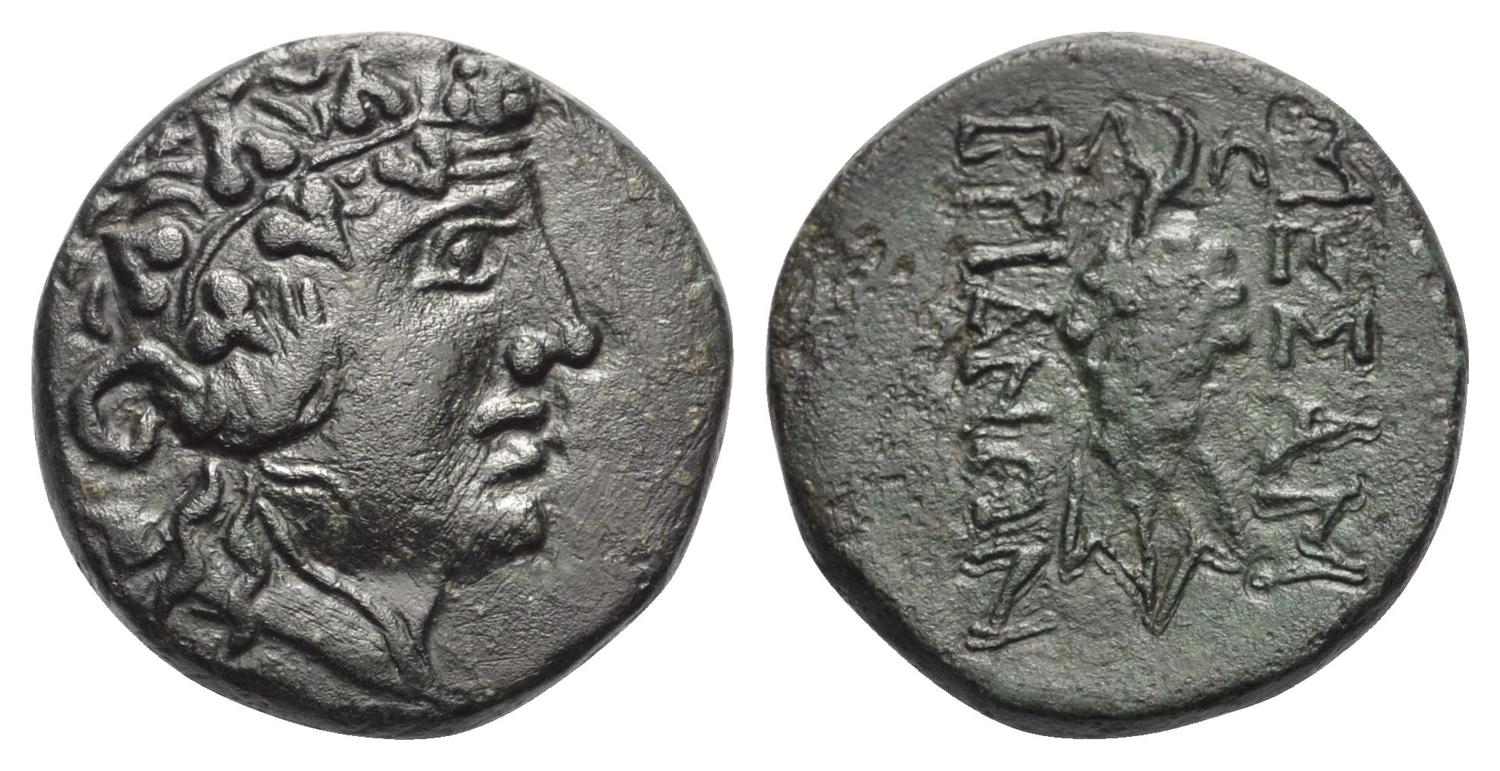Mesembria, bronze 6.50g (Dionysus/bunch of grapes) (100-50 BCE)
From SILVER
100 BCE - 50 BCE Bronze
Description
| ObverseInscription or printing placed on the obverse.: | Head of Dionysos right, waring ivy wreath. |
| ReverseInscription or printing placed on the reverse.: | ΜΕΣΑΜΒΡΙΑΝΩΝ (Greek).Bunch of grape. |
Mint and issuing power
| MintIdentifies the place of manufacture or issue of a numismatic object.: | Mesembria | Ancient regionAncient region.: | Thrace | Modern countryModern country: Bulgaria | AuthorityIdentifies the issuing power. The authority can be "pretended" when the name or the portrait of X is on the coin but he/she was not the issuing power. It can also be "uncertain" when there is no mention of X on the coin but he/she was the issuing power according to the historical sources: |
Chronology
| FromIdentifies the initial date in a range assigned in a numismatic context. | 100 BCE | toIdentifies the final date in a range assigned in a numismatic context.. | 50 BCE | PeriodTime period of the numismatic object.: Hellenistic 323-30 BC |
Physical description
| MetalThe physical material (usually metal) from which an object is made.: | Bronze |
Median weightMedian of the weights of numismatic objects (in grams). in grams | 6.50 | DenominationTerm indicating the value of a numismatic object. Examples: tetradrachm, chalkous, denarius.: | StandardStandard.: |
Image

RQEM ad. 1198 - Mesembria, bronze, 100-50 BC.jpg [1]
References
| Die study referencePublication of the study: | Karayotov 20091Karayotov 2009, p. 390-395 | ||
| Coin series referenceReference to coin series study: | HGC 3.22HGC 3.2, n° 1574 | ||
Obverse dies distribution
| FrequencyFrequency of specimen in distribution. ᵖ | Number of obversesNumber of obverse dies. ᵖ (o) | % (o) | Number of coinsNumber of coins. (n) | % (n) | Die nameName(s) of the die(s). |
| 1 | 4 | 25 | 4 | 7.55 | 4, 12, 14, 15 |
| 2 | 4 | 25 | 8 | 15.09 | 2, 3, 6, 11 |
| 3 | 3 | 18.75 | 9 | 16.98 | 5, 8, 13 |
| 4 | 1 | 6.25 | 4 | 7.55 | 16 |
| 5 | 1 | 6.25 | 5 | 9.43 | 1 |
| 6 | 1 | 6.25 | 6 | 11.32 | 9 |
| 7 | 1 | 6.25 | 7 | 13.21 | 7 |
| 10 | 1 | 6.25 | 10 | 18.87 | 10 |
| Total | 16 of 16 | 100 | 53 of 53 | 100 |
Reverse dies distribution
no distribution is available
Quantification
| Number of obversesNumber of obverse dies. ᵖ (o) | 16 | Number of singletons (o1)The number of singleton coins. ᵖ | 4 |
| Number of reverse diesNumber of reverse dies. (r) | 31 | Number of coinsNumber of coins. (n) | 53 |
| Coins per obverse dieNumber of coins per obverse die. (n/o) | 3.31 | Coins per reverse dieNumber of coins per reverse die. (n/r) | 1.71 |
| Reverse per obverse ratioRatio of obverse dies divided by reverse dies. (r/o) | 1.94 | Percentage of singletons (o1)number of coins (n) divided by the number of singletons (o1) ᵖ | 25 % |
| Original number of dies (O) (Carter 1983 formula)The estimation of the number of coins according to Carter 1983 ᵖ | 19.64 | Coins struck if 20,000 as average productivity per dieCoins made if the average productivity for obverses (according to Carter) is 20,000. ᵖ | 392,800 |
| Original number of dies (O) (Esty 2011 formula)The estimation of the number of coins according to the singleton formula in Esty 2011 ᵖ (O) | 22.92 | Survival rate if 20,000 as average productivity per dieSurvival rate if average productivity is 20,000. ᵖ | 0.00013 |
| Coverage (o = % of O) (Esty 1984 formula)Esty 1984 - coverage (% of O) ᵖ (o = % of O) | 92.45% | Die productivity if survival rate 1/2,000Average productivity if survival rate is 1/2,000. ᵖ | 5,397.15 |
| Weight of silver (in kg) if 20,000 coins per die (O = Carter formula)Carter 1983 * Median weight * 20000 (*10 if gold or electrum) ᵖ | n.a. | Die productivity if survival rate 1/5,000Average productivity if survival rate is 1/5,000. ᵖ | 13,492.87 |
Remarks